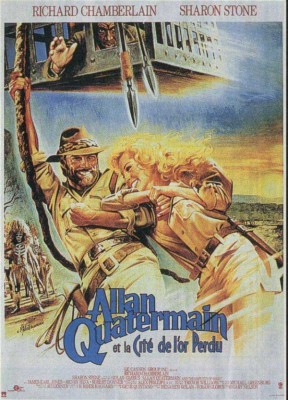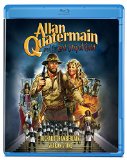| Reviews & Columns |
|
Reviews DVD TV on DVD Blu-ray 4K UHD International DVDs In Theaters Reviews by Studio Video Games Features Collector Series DVDs Easter Egg Database Interviews DVD Talk Radio Feature Articles Columns Anime Talk DVD Savant Horror DVDs The M.O.D. Squad Art House HD Talk Silent DVD
|
DVD Talk Forum |
|
|
| Resources |
|
DVD Price Search Customer Service #'s RCE Info Links |
|
Columns
|
|
|
Allan Quatermain and the Lost City of Gold
The movie is far from good, but harmless entertainment that's reasonably enjoyable if viewed in the right frame of mind. Though prompted by the phenomenal success of Raiders of the Lost Ark (1981) and, to a lesser extent, Indiana Jones and the Temple of Doom (1984), borrowing some elements from those pictures, mostly it's an old-fashioned, dumb but innocent Dark Continent adventure more in the tradition of Hollywood jungle movies of the 1930s-‘50s. Just as the Indiana Jones movies emulated the chapter-plays of that same era, Quatermain draws on traditional Hollywood storytelling dating back even further, specifically H. Rider Haggard's 1885 sequel to King Solomon's Mines, the "best-selling classic novel" (says the credits) Allan Quatermain.
Olive Films' Blu-ray, provided by MGM, is problematic. The transfer looks great but the audio is so flat as to significantly diminish the viewing experience. The movie was originally released in Ultra-Stereo (similar to Dolby Stereo Matrix), and while MGM's 2004 DVD featured Dolby Stereo Surround, the new Blu-ray is DTS-HD Master Audio 2.0 mono. Oddly, the first movie with the same leads, King Solomon's Mines, isn't out yet on Blu-ray.
Filmed in Zimbabwe, Quatermain opens with Allan (Richard Chamberlain) and geologist girlfriend Jesse Huston (Sharon Stone), having survived their adventures at King Solomon's Mines, living in colonial Africa, making preparations to marry. A colleague of Allan's, chased for many miles by hostile natives, turns up at their doorstep with word that Allan's long-lost brother, Robeson (Martin Rabbett, Chamberlain's real-life partner), is alive and living among a fabled white race in the Lost City of Gold.
Quatermain mounts a new expedition, with intimidating African warrior Umslopogaas (James Earl Jones, in a surprisingly silly and undistinguished role) and cowardly, greedy Indian holy man Swarma (Western character actor Robert Donner) joining Allan and Jesse.
After many wild incidents, including a colossal trap-door that nearly drops the entire party into an enormous pit, and a Disneyland-like flume ride through some caverns, they eventually reach the Lost City, peacefully inhabited by both black Africans and blonde-haired whites. However, slave trader-turned-high-priest Agon (Henry Silva), aided by Queen Sorais* (Cassandra "Elvira" Peterson), greedily smuggles the gold out of the kingdom when not turning prisoners into instant statues with the molten metal, and threatens all.
The movie is hokey with many ludicrous qualities yet hard to hate. Despite its low-rent Indiana Jones origins, both it and King Solomon's Mines are straightforward and sincere. Some regard both films as adventure-comedies if not downright spoofs, but there's much less humor and a more serious approach than the Roger Moore Bond films of the same period, and probably even a bit less than found in the Indiana Jones pictures. Mostly it's trying hard to elicit a sense of wonder, innocent fun and excitement.
But Allan Quatermain and the Lost City of Gold is awfully silly: James Earl Jones's character wields a double-bit axe whose blade in many shots which is obviously a soft piece of rubber painted silver. When a charging lion threatens the party, Quatermain shoots it, at which point it instantly becomes an unevenly stuffed one with the body shape of a dachshund.
A major plot point revolves around a protective material Quatermain wears under his shirt that no blade can penetrate. It resembles (and might even be) delicate silver lamé, the kind of thing Cher might wear to the Oscars. Throughout the film native spears bounce harmlessly off Quatermain's chest, but even if they didn't break the skin, wouldn't a javelin striking the body at 70mph smart a bit? Not Quatermain.
The Lost City of Gold seems to be composed not of gold bricks but spray-painted molded plastic and Styrofoam blocks that bounce when they hit the ground. When the gold is melted down it resembles butterscotch sauce. With his frizzy shock of black hair and flowing robes, Henry Silva's wild-eyed, screaming villain looks like "Weird Al" Yankovic at a costume party dressed as the Wizard of Speed and Time.
The visual effects, by Cannon's in-house effects unit, alternate between pretty good (some matte shots) and terrible (some of the miniatures). Still, it's pretty fun stuff, less like something produced with the deep pockets of Industrial Light & Magic and more akin to those seen in the Edgar Rice Burroughs movie adaptations of the 1970s.
Cannon was in such financial straits that by postproduction the company opted to reuse music Jerry Goldsmith had written for King Solomon's Mines for a good portion of Quatermain's score. One theme is repeated so often the movie audience will want to scream. (Another Cannon film from this time, The Delta Force, endlessly repeats its theme music in much the same way.)
Video & Audio
On the plus side, Allan Quatermain and the Lost City of Gold looks great. Filmed in 2.35:1 J-D-C Scope, the image has strong color (showing off the picture's impressive locations) and sharpness (mosquito netting, the wireworks holding up the actors in several scenes). The sound, however, is notably flat, taking viewers out of the action. As noted above the Ultra-Stereo theatrical version was approximated in the Dolby Stereo Surround DVD, but here the DTS-HD Master Audio is 2.0 mono only, and far from impressive. No alternate audio or subtitle options.
Extra Features
The lone supplement is a trailer, 1.85:1 widescreen, in high-def, though grainy.
Parting Thoughts
Neither as good as it might be not as bad as its reputation would suggest, Allan Quatermain and the Lost City of Gold actually would function well as a Saturday matinee for the kids. It's silly and even ludicrous at times, but still enjoyable. Rent It.
* She's quite fetching, and unplagued by psoriasis.
Stuart Galbraith IV is the Kyoto-based film historian and publisher-editor of World Cinema Paradise. His credits include film history books, DVD and Blu-ray audio commentaries and special features.
|
| Popular Reviews |
| Sponsored Links |
|
|
| Sponsored Links |
|
|
| Release List | Reviews | Shop | Newsletter | Forum | DVD Giveaways | Blu-Ray | Advertise |
|
Copyright 2024 DVDTalk.com All Rights Reserved. Legal Info, Privacy Policy, Terms of Use,
Manage Preferences,
Your Privacy Choices | |||||||
















